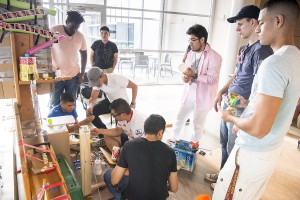ORLANDO — The scene in West Campus’s engineering building looked a little like the set from “Sanford and Son” collided with TV’s “Myth Busters.”
Scattered all over Building 11 were piles of supplies – boxes of junk that appeared to have been scavenged from toy boxes and tool boxes. Toy train tracks, Legos, Hot Wheels cars. Drills, PVC pipe and mousetraps. Balloons, marbles, dominoes. A Slinky. And duct tape. Lots and lots of duct tape.
The reason? If it’s the end of the semester, it’s time for the engineering students to complete their Rube Goldberg project. Divided into 10 teams, the 175 engineering students on Monday assembled Rube Goldberg machines – comically complex machines that take many steps to perform a simple task.
The project is the final class assignment for Valencia’s Introduction to the Engineering Profession class (EGS 1006C). Working with as many as 19 other students, the budding engineers had to learn teamwork.

“That’s the most important lesson they need to learn from this,” said Prof. Charles Davis, a former industrial engineer who now teaches the class and serves as advisor for Valencia’s engineering students.
Along the way, however, the students not only bonded, but had fun devising the kookiest contraptions they could imagine.
“I think it was fun because we got to know each other and combine each other’s ideas,” said Jason Arroyo, 27.
“It gives you the opportunity to be creative and think outside the box,” said Alejandro Rodriguez, 21, of Team 9.
Most of the teams built their contraptions in someone’s garage – and then faced the challenge of transporting it to the college for judging and grading. For some, moving the devices presented some problems.
Machines that previously worked without a hitch didn’t always fire up – after they’d been moved to the campus. Each team gets three tries to show their professor that the device will work. After that, they lose points.
“When we were first building it, it worked every single time,” said Daniela Castaneda, 22, of Team 2. “So it was kind of alarming when it didn’t work the first two times.”

Castaneda, who wants to study electrical engineering with the goal of going into the solar energy field, said the project was “definitely fun and rewarding” – and her team finally got their Rube Goldberg device to work on their third and final attempt.
Only the Willy Wonka team – who were inspired to create an “Everlasting Gobstoppers” machine, much like the one in the film – successfully completed the challenge on the first try.
“In the movie, he pushes a button to start the machine — ours is operated by a wooden coin – and then the machine does all these crazy things and pushes out this tiny little Gobstopper,” said engineering student Eric Mason. “The end result is, a door drops open and a box of Wonka Everlasting Gobstoppers appears – as if it’s a giant vending machine.”
The team, led by Mason, Sean Lear and Nick Martin, assembled their enormous contraption at Lear’s house – and built it on top of a huge wooden platform. They then carted the platform to the West Campus and into Building 11 for the judging.
For the students on the Willy Wonka team, the most important lesson learned from the project was the value of teamwork.
“Uniting as a team made the project flow so much smoother than each person trying to individually push their own ideas,” said Mason, a veteran who’s planning to study civil engineering. “When you are trying to design something from nothing, everybody has ideas all over the place and everybody’s throwing out ideas. Well, after you’ve been doing this for eight hours on end, you can feel the tension in the air — and you learn quickly that that has no place in getting the job done. You learn to squash the tension and collectively get the job done.”
